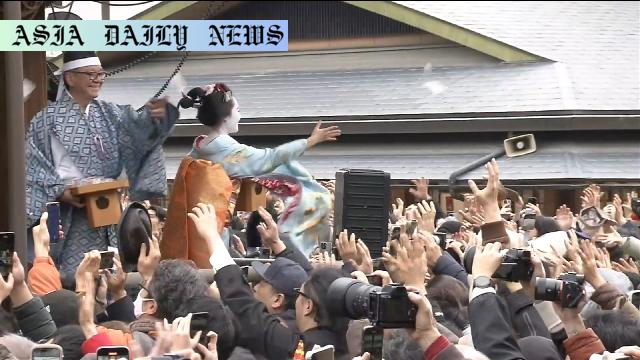Setsubun, the Japanese tradition celebrated with bean throwing, marks a prayer for good health and happiness in Kyoto’s Yasaka Shrine.
Setsubun marks the last day of winter on Japan’s lunar calendar.
Kyoto’s Yasaka Shrine hosts annual ceremonies promoting good health.
Maiko apprentices perform dances and partake in bean-throwing rituals.
Onlookers partake in catching beans said to bring good fortune.

Introduction to Setsubun
Setsubun, celebrated as the last day of winter on the lunar calendar, is one of Japan’s most culturally significant traditions. Observed annually, it features ceremonies, performances, and rituals meant to drive away evil spirits while ushering in good fortune and health. In Kyoto, this tradition is particularly prominent at the Yasaka Shrine, where both locals and visitors gather to partake in this joyous occasion.
The Historic Yasaka Shrine and Event Highlights
Located in the heart of Kyoto, the Yasaka Shrine serves as the epicenter of Setsubun celebrations. Over a span of two days, this sacred site not only embraces traditional practices but also infuses them with charm through live performances from geiko and maiko entertainers from the Gionkobu district. These cultural icons offer a unique insight into Japan’s rich traditions as they perform traditional dances dressed in stunning attire, captivating attendees as part of the Setsubun festivities.
The Ritual of Bean Throwing
A central activity during Setsubun is the throwing of beans, called “mame-maki,” believed to expel malevolent spirits and invite good luck. During the Yasaka Shrine event, participants, including maiko and other volunteers, toss small bags of beans to eager onlookers. The rhythmic beats of the drums create an infectious atmosphere as spectators scramble to catch the beans, tokens of health and prosperity. Tradition dictates that these beans, once caught, must be eaten—or thrown in one’s home—to ensure a brighter year ahead.
A Maiko Performance to Remember
A unique highlight of Kyoto’s Setsubun celebration is the mesmerizing dance performance by maiko, or apprentice geiko entertainers. Their elegant movements and vibrant kimonos transport audiences back to Kyoto’s historical past. This year’s performance drew spectators from all over, including families eager to experience this hallmark of Kyoto’s cultural identity. May it be the intricate hand gestures or the serene expressions on their faces, the maiko brought artistry and tradition to the forefront of the event.
Interactivity and Family Joy
Among the many attendees, a heartwarming scene was captured as a father expressed his disappointment at missing out on catching beans but shared his gratitude after being offered a few by a fellow attendee. Such moments exemplify Setsubun’s spirit of togetherness and generosity. For families, the event provides an opportunity to teach children the importance of cultural rituals while enjoying a shared activity that fosters connection and warmth.
Conclusion: Setsubun’s Timeless Relevance
Despite its historical roots, Setsubun remains a living tradition that resonates with people across Japan and beyond. By combining dance, community, and ancient customs, Kyoto’s Yasaka Shrine ensures that this cultural celebration continues to thrive in modern times. The festival not only reminds participants to reflect on their goals and health for the year ahead but also demonstrates the enduring power of traditions in bringing people together.



Commentary
Reflection on the Beauty of Setsubun
Setsubun in Kyoto, particularly at Yasaka Shrine, showcases the enduring brilliance of Japanese cultural traditions. It’s fascinating how such an ancient custom continues to inspire joy and unity. The maiko performances, with their elegance, stand as a beautiful bridge between Japan’s past and its present, revealing the deep respect the nation holds for its heritage.
The Power of Community During Festivals
What stands out in events like Setsubun is the sense of togetherness they invoke. The image of families gathering to catch beans, laughing, and sharing moments of kindness, demonstrates how traditions foster strong community bonds. Even those who don’t manage to catch a bean find themselves enriched by the shared spirit of goodwill.
Why Traditions Like Setsubun Matter
In an era dominated by technology and changing global cultures, practices like Setsubun are essential. They act as a reminder of who we are and where we come from. Kyoto’s dedication to preserving and celebrating such traditions ensures that future generations remain connected to their roots while finding joy and purpose in the simplest acts, like tossing a bag of beans. With festivals like this, we’re reminded that bridging the past and present isn’t just possible—it’s vital.